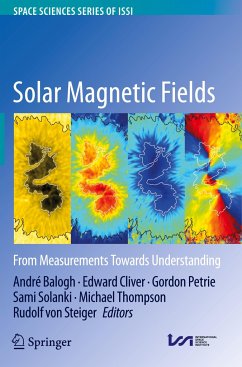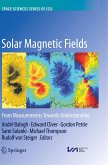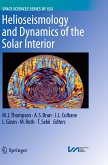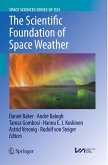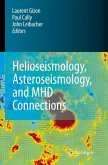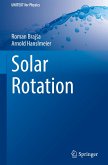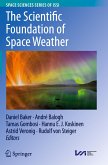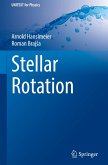Solar Magnetic Fields
From Measurements Towards Understanding
Herausgegeben:Balogh, André; Cliver, Edward; Petrie, Gordon; Solanki, Sami; Thompson, Michael; von Steiger, Rudolf
Solar Magnetic Fields
From Measurements Towards Understanding
Herausgegeben:Balogh, André; Cliver, Edward; Petrie, Gordon; Solanki, Sami; Thompson, Michael; von Steiger, Rudolf
- Gebundenes Buch
- Merkliste
- Auf die Merkliste
- Bewerten Bewerten
- Teilen
- Produkt teilen
- Produkterinnerung
- Produkterinnerung
This volume provides an in-depth review of all aspects of solar magnetic fields. Written by world-leading experts, these thirteen papers cover all regions of the subject from the solar interior, photosphere, chromosphere, active regions, and corona out to the solar wind. The history of solar magnetic fields as well as the necessary instrumentation are also covered. The volume serves as both a reference for researchers and a starting point for graduate students. Originally published in Space Science Reviews, Volume 210, Issue 1-4, September 2017
Andere Kunden interessierten sich auch für
![Solar Magnetic Fields Solar Magnetic Fields]() Solar Magnetic Fields75,99 €
Solar Magnetic Fields75,99 €![Helioseismology and Dynamics of the Solar Interior Helioseismology and Dynamics of the Solar Interior]() Helioseismology and Dynamics of the Solar Interior75,99 €
Helioseismology and Dynamics of the Solar Interior75,99 €![The Scientific Foundation of Space Weather The Scientific Foundation of Space Weather]() The Scientific Foundation of Space Weather112,99 €
The Scientific Foundation of Space Weather112,99 €![Helioseismology, Asteroseismology, and MHD Connections Helioseismology, Asteroseismology, and MHD Connections]() Helioseismology, Asteroseismology, and MHD Connections112,99 €
Helioseismology, Asteroseismology, and MHD Connections112,99 €![Solar Rotation Solar Rotation]() Roman BrajsaSolar Rotation52,99 €
Roman BrajsaSolar Rotation52,99 €![The Scientific Foundation of Space Weather The Scientific Foundation of Space Weather]() The Scientific Foundation of Space Weather113,99 €
The Scientific Foundation of Space Weather113,99 €![Stellar Rotation Stellar Rotation]() Arnold HanslmeierStellar Rotation52,99 €
Arnold HanslmeierStellar Rotation52,99 €-
-
-
This volume provides an in-depth review of all aspects of solar magnetic fields. Written by world-leading experts, these thirteen papers cover all regions of the subject from the solar interior, photosphere, chromosphere, active regions, and corona out to the solar wind. The history of solar magnetic fields as well as the necessary instrumentation are also covered. The volume serves as both a reference for researchers and a starting point for graduate students.
Originally published in Space Science Reviews, Volume 210, Issue 1-4, September 2017
Originally published in Space Science Reviews, Volume 210, Issue 1-4, September 2017
Produktdetails
- Produktdetails
- Space Sciences Series of ISSI 57
- Verlag: Springer / Springer Netherlands
- Artikelnr. des Verlages: 978-94-024-1520-9
- 1st ed. 2018
- Seitenzahl: 432
- Erscheinungstermin: 6. Juni 2018
- Englisch
- Abmessung: 241mm x 160mm x 28mm
- Gewicht: 808g
- ISBN-13: 9789402415209
- ISBN-10: 9402415203
- Artikelnr.: 51934864
- Herstellerkennzeichnung
- Springer-Verlag GmbH
- Tiergartenstr. 17
- 69121 Heidelberg
- ProductSafety@springernature.com
- Space Sciences Series of ISSI 57
- Verlag: Springer / Springer Netherlands
- Artikelnr. des Verlages: 978-94-024-1520-9
- 1st ed. 2018
- Seitenzahl: 432
- Erscheinungstermin: 6. Juni 2018
- Englisch
- Abmessung: 241mm x 160mm x 28mm
- Gewicht: 808g
- ISBN-13: 9789402415209
- ISBN-10: 9402415203
- Artikelnr.: 51934864
- Herstellerkennzeichnung
- Springer-Verlag GmbH
- Tiergartenstr. 17
- 69121 Heidelberg
- ProductSafety@springernature.com
¿André Balogh is Emeritus Professor of Space Physics, Imperial College, London.Through his career since the 1960s he led or participated in numerous space investigations into the physics of the heliospheric magnetic field and its interaction with the solar wind and the Earth's space environment. As Principal Investigator of the magnetic field investigation on the joint ESA/NASA Ulysses (1990-2009) mission he led numerous research projects to discover the dynamics and evolution of the three-dimensional heliospheric magnetic field and its connection with solar magnetism through the solar activity cycle. From 2005 to 2010 he was a Director of the International Space Science Institute where he initiated and organised a series of workshops on magnetic fields in the solar system and beyond, and has been the editor of 12 volumes in the Space Science Series of ISSI. Ed Cliver holds an MS in Astrogeophysics from the University of Colorado (1973) anda DSc in Solar-terrestrial physics from Nagoya University (2000). He worked in the general area of space weather at the Air Force Research Laboratory from 1979-2014 and became an emeritus astronomer at the National Solar Observatory upon retirement. He has served on the Editorial Board of Solar Physics since 1998. He is the author of over 100 papers with areas of focus including solar energetic particles, solar-terrestrial coupling, large-scale solar waves, extreme events, space climate, and the history of solar-terrestrial physics. He was a co-organizer of the community-wide effort from 2011-2015 to recalibrate the sunspot number which continues under an ISSI International Team. He was a member of an ISSI Team formed in 2011 that produced a high-confidence reconstruction of the solar wind magnetic field since 1845 and a simulation of the magnetic states of the photosphere and the solar wind during the Maunder Minimum. Gordon Petrie has been a Researcher at National Solar Observatory since 2007. His research has covered a broad range of topics in the field of solar magnetism, including photospheric, chromospheric and coronal magnetic fields and their dependence on the solar activity cycle. He has published over 50 scientific papers on the observation and interpretation of solar magnetic measurements, in particular on the changes that lead to the evolution of solar activity both on the surface and in the solar atmosphere. His work has connected solar magnetic fields to heliospheric phenomena, in particular to the solar wind, Coronal Mass Ejections and the heliospheric magnetic field. Sami Solanki is Director of the Max Planck Institute for Solar System Research (MPS) in Gottingen, Germany. He is a leading figure in solar physics in general an solar magnetism in particular through his active leadership of both experimental and analytical aspects of international solar research projects, such as GREGOR, a 1.5-m solar telescope operated on Tenerife, the SUNRISE balloon-borne solar telescope and the Polarimetric and Helioseismic Imager instrument to be flown on the Solar Orbiter Mission of the European Space Agency. He is the author of several hundred scientific papers on solar and heliospheric topics and the speaker at the International Max Planck Research School for Solar System Science at the University of Göttingen. He is Editor-in-Chief of the online review journal Living Reviews in Solar Physics and he holds professorial appointments at the at the Eidgenössische Technische Hochschule, Zürich and at the Technische Universität Braunschweig. Michael Thompson is the Deputy Director and Chief Operating Officer of the National Center for Atmospheric Research (NCAR), and an NCAR Senior Scientist. From 2010 to 2014 he was Director of the High Altitude Observatory and an Associate Director of NCAR. Prior to joining NCAR, Michael was Head of the School of Mathematics and Statistics in the University of Sheffield, United Kingdom, and was formerly a Professor of Physics at Imperial College London. Dr. Thompson's scientific research activity is principally in helioseismology, asteroseismology, solar physics, and inverse problems. He has worked extensively in developing and applying inverse techniques in helioseismology, and in particular measuring the stratification, rotation, and large-scale flows in the solar interior. Dr. Thompson has published widely on the interpretation of helioseismologic observations that have brought new insights into the origin and evolution of solar magnetic fields. Rudolf von Steiger holds an MSc in theoretical physics (1984), a PhD in experimental physics (1988), and a habilitation in extraterrestrial physics (1995) from the University of Bern. He was a CoI of the Solar Wind Ion Composition Experiment (SWICS) on Ulysses and an associated scientist of the AMPTE and ACE missions. His relevant experience includes theoretical modelling of solar chromospheric processes, specifically of the FIP fractionation effect, as well as the analysis and interpretation of solar wind observations both in the Earth's magnetosheath and in interplanetary space. In 1995 he joined the newly created International Space Science Institute (ISSI) in Bern as senior scientist. Since 1999 he is a director there and also holds an associate professorship at the University of Bern. He serves as an editor of Space Science Reviews, Frontiers in Space Science , and Living Reviews in Solar Physics.
Editorial: Measuring Solar Magnetic Fields-An Outline of History, Current Status and Challenges.- History of Solar Magnetic Fields Since George Ellery Hale.- Measurements of Photospheric and Chromospheric Magnetic Fields.- Polar Field Reversals and Active Region Decay.- Radiative Diagnostics in the Solar Photosphere and Chromosphere.- Magnetic Diagnostics of the Solar Corona: Synthesizing Optical and Radio Techniques.- The Physics and Diagnostic Potential of Ultraviolet Spectropolarimetry.- Minimal Magnetic States of the Sun and the Solar Wind: Implications for the Origin of the Slow Solar Wind.- Coronal Magnetic Field Models.- Solar Magnetoconvection and Small-Scale Dynamo.- The Life Cycle of Active Region Magnetic Fields.- Surface Flux Transport and the Evolution of the Sun's Polar Fields.- The Global Solar Dynamo.- Prospects of Solar Magnetometry-From Ground and in Space.
Editorial: Measuring Solar Magnetic Fields-An Outline of History, Current Status and Challenges.- History of Solar Magnetic Fields Since George Ellery Hale.- Measurements of Photospheric and Chromospheric Magnetic Fields.- Polar Field Reversals and Active Region Decay.- Radiative Diagnostics in the Solar Photosphere and Chromosphere.- Magnetic Diagnostics of the Solar Corona: Synthesizing Optical and Radio Techniques.- The Physics and Diagnostic Potential of Ultraviolet Spectropolarimetry.- Minimal Magnetic States of the Sun and the Solar Wind: Implications for the Origin of the Slow Solar Wind.- Coronal Magnetic Field Models.- Solar Magnetoconvection and Small-Scale Dynamo.- The Life Cycle of Active Region Magnetic Fields.- Surface Flux Transport and the Evolution of the Sun's Polar Fields.- The Global Solar Dynamo.- Prospects of Solar Magnetometry-From Ground and in Space.

